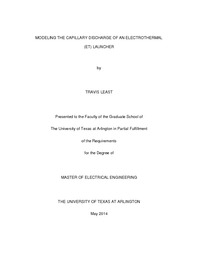
ATTENTION: The works hosted here are being migrated to a new repository that will consolidate resources, improve discoverability, and better show UTA's research impact on the global community. We will update authors as the migration progresses. Please see MavMatrix for more information.
Show simple item record
| dc.contributor.author | Least, Travis | en_US |
| dc.date.accessioned | 2014-07-14T20:27:11Z | |
| dc.date.available | 2014-07-14T20:27:11Z | |
| dc.date.issued | 2014-07-14 | |
| dc.date.submitted | January 2014 | en_US |
| dc.identifier.other | DISS-12544 | en_US |
| dc.identifier.uri | http://hdl.handle.net/10106/24442 | |
| dc.description.abstract | Over the past few decades, different branches of the US Department of Defense (DoD) have invested at improving the field ability of electromagnetic launchers. One such focus has been on achieving hypervelocity launch velocities in excess of 7 km/s for direct launch to space applications [1]. It has been shown that pre-injection is required for this to be achieved. One method of pre-injection which has promise involves using an electro-thermal (ET) due to its ability to achieve the desired velocities with a minimal amount of hot plasma injected into the launcher behind the projectile. Despite the demonstration of pre-injection using this method, polymer ablation is not very well known and this makes it challenging to predict how the system will behave for a given input of electrical power. In this work, the rate of ablation has been studied and predicted using different models to generate the best possible characteristic curve. | en_US |
| dc.description.sponsorship | Wetz Jr., David A. | en_US |
| dc.language.iso | en | en_US |
| dc.publisher | Electrical Engineering | en_US |
| dc.title | Modeling The Capillary Discharge Of An Electrothermal (ET) Launcher | en_US |
| dc.type | M.Engr. | en_US |
| dc.contributor.committeeChair | Wetz Jr., David A. | en_US |
| dc.degree.department | Electrical Engineering | en_US |
| dc.degree.discipline | Electrical Engineering | en_US |
| dc.degree.grantor | University of Texas at Arlington | en_US |
| dc.degree.level | masters | en_US |
| dc.degree.name | M.Engr. | en_US |
Files in this item
- Name:
- Least_uta_2502M_12544.pdf
- Size:
- 2.307Mb
- Format:
- PDF
This item appears in the following Collection(s)
Show simple item record


